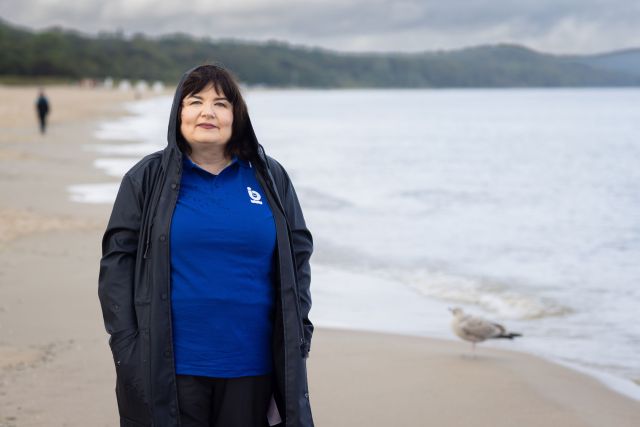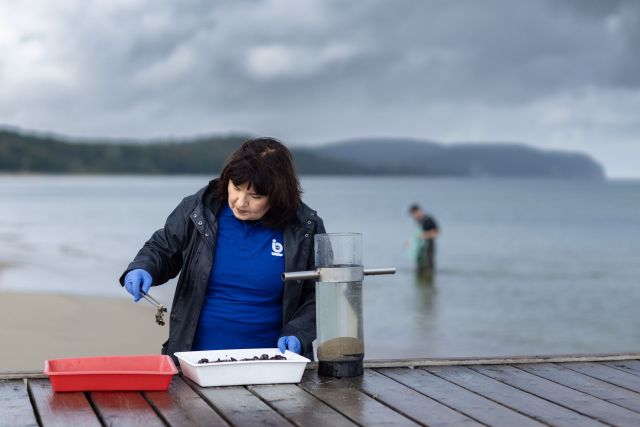Principal Investigator
:
Prof. dr hab. Ksenia Pazdro
Institute of Oceanology Polish Academy of Sciences
Panel: NZ8
Funding scheme
: BiodivProtect
announced on
1 October 2021
Marine ecosystems today are facing many problems, such as anthropogenic threats, climate change and other factors that negatively affect their health and function. This is also true of the Baltic Sea. The peculiar geographical and hydrological features of the Baltic make it particularly vulnerable to different anthropogenic pressures.
 Prof. Ksenia Pazdro, photo by Michał Łepecki
The Baltic Sea is a semi-enclosed basin with brackish waters and relatively low biodiversity. It is located in a densely populated region, with intensive agricultural and industrial activity underway within its catchment area. In addition, its waters account for c. 15% of global marine transport. As a result, chemical pollution is a major threat, which negatively affects the health of Baltic fauna and flora and, by corollary, its overall biodiversity. National, regional and EU remediation measures thus far have improved the situation; the amount of hazardous substances discharged into the sea has been reduced. However, they continue to be present in the ecosystem, and extreme weather phenomena, such as sea storms, increase the risk of their reintroduction into the Baltic. Attention should also be drawn to a new group of compounds, known as micropollutants (such as pharmaceuticals, plasticizers, detergents, personal protection agents). Micropollutants are eliminated during wastewater treatment to varying degrees, but little is known about their impact on living organisms. Keeping a large ecosystem like the Baltic Sea in good health thus requires further, decisive measures by institutions responsible for marine ecosystem protection. To this end, however, they need modern, reliable and useful tools. Monitoring activities thus far have focused on two lines of investigation: the chemical composition of the environment and the assessment of the health of marine organisms. However, to date, research has only considered the impact of selected, individual substances, rather than the entire “cocktail” of chemical elements and compounds present in the Baltic.
Prof. Ksenia Pazdro, photo by Michał Łepecki
The Baltic Sea is a semi-enclosed basin with brackish waters and relatively low biodiversity. It is located in a densely populated region, with intensive agricultural and industrial activity underway within its catchment area. In addition, its waters account for c. 15% of global marine transport. As a result, chemical pollution is a major threat, which negatively affects the health of Baltic fauna and flora and, by corollary, its overall biodiversity. National, regional and EU remediation measures thus far have improved the situation; the amount of hazardous substances discharged into the sea has been reduced. However, they continue to be present in the ecosystem, and extreme weather phenomena, such as sea storms, increase the risk of their reintroduction into the Baltic. Attention should also be drawn to a new group of compounds, known as micropollutants (such as pharmaceuticals, plasticizers, detergents, personal protection agents). Micropollutants are eliminated during wastewater treatment to varying degrees, but little is known about their impact on living organisms. Keeping a large ecosystem like the Baltic Sea in good health thus requires further, decisive measures by institutions responsible for marine ecosystem protection. To this end, however, they need modern, reliable and useful tools. Monitoring activities thus far have focused on two lines of investigation: the chemical composition of the environment and the assessment of the health of marine organisms. However, to date, research has only considered the impact of selected, individual substances, rather than the entire “cocktail” of chemical elements and compounds present in the Baltic.
 Prof. Ksenia Pazdro, photo by Michał Łepecki
The Detect2Protect project proposes a change of paradigm in Baltic protection and a shift toward a more holistic approach focused on biological effect-based methods (EBM). There is increasing evidence that effect-based methods may help distinguish chemical toxicity from other possible causes of biodiversity loss and serve as an early warning sign of potential threats. The goal of the project is to improve our understanding of the cause-and-effect relationships between environmental pollution and changes in biodiversity and develop a tool for environmental risk assessment in different Baltic regions. To this end, we will use specific biomarkers, i.e. biochemical indicators of the impact of pollutants on marine organisms. The project involves harmonised research by teams from marine research institutions in Finland, Estonia, Latvia, Lithuania, Sweden, Poland and Italy, with the aim of tracking relationships between chemical pollution in the Baltic and potential biodiversity loss, based on existing chemical pollution monitoring and biological data. We will also carry out joint fieldwork in the coastal regions of Poland, Latvia, Lithuania, Estonia, Sweden and Finland to compare polluted sites with reference sites. Our project will involve measurements of chemical pollutant concentrations in various elements of the environment and their biological effects in representative species of molluscs, crustaceans, polychaeta and fish in each region. Biodiversity will be assessed through eDNA metabarcoding. In order to develop appropriate predictive modelling tools, we will also need a thorough analysis and integration of collected data.
Prof. Ksenia Pazdro, photo by Michał Łepecki
The Detect2Protect project proposes a change of paradigm in Baltic protection and a shift toward a more holistic approach focused on biological effect-based methods (EBM). There is increasing evidence that effect-based methods may help distinguish chemical toxicity from other possible causes of biodiversity loss and serve as an early warning sign of potential threats. The goal of the project is to improve our understanding of the cause-and-effect relationships between environmental pollution and changes in biodiversity and develop a tool for environmental risk assessment in different Baltic regions. To this end, we will use specific biomarkers, i.e. biochemical indicators of the impact of pollutants on marine organisms. The project involves harmonised research by teams from marine research institutions in Finland, Estonia, Latvia, Lithuania, Sweden, Poland and Italy, with the aim of tracking relationships between chemical pollution in the Baltic and potential biodiversity loss, based on existing chemical pollution monitoring and biological data. We will also carry out joint fieldwork in the coastal regions of Poland, Latvia, Lithuania, Estonia, Sweden and Finland to compare polluted sites with reference sites. Our project will involve measurements of chemical pollutant concentrations in various elements of the environment and their biological effects in representative species of molluscs, crustaceans, polychaeta and fish in each region. Biodiversity will be assessed through eDNA metabarcoding. In order to develop appropriate predictive modelling tools, we will also need a thorough analysis and integration of collected data.
We hope our findings will help define the relationship between water pollution in the Baltic Sea and the biochemical reaction of its organisms, as well as to identify indicator species and biomarkers for different marine regions which, it is hoped, will facilitate biodiversity protection. Our findings, including a field-tested set of biological indicators (as an early warning tool) and recommendations for use in different areas of the Baltic Sea, will be presented to interested institutions, such as HELCOM. We will also share what we have learned with the general public, so as to raise public awareness of the impact of chemical mixtures on potential biodiversity loss in the Baltic Sea.
Project title: Detect2Protect: New approaches in determining the impacts of chemical pollution to protect the biodiversity of the Baltic Sea
Prof. dr hab. Ksenia Pazdro
A marine chemist, she graduated in oceanography from the University of Gdańsk. Since the early days of her career, she has been affiliated with the Department of Marine Chemistry and Biochemistry of the Institute of Oceanology of the Polish Academy of Sciences in Sopot. In 2021, she earned the title of professor ofexact and natural sciences. Her research interests centre on the circulation of persistent organic pollutants and emerging pollutants (e.g. pharmaceuticals) in marine ecosystems (the Baltic Sea and the Svalbard fjords) and assessing their impact on marine organisms. She is an author of several publications in international journals and has participated in the work of the Polish Scientific Committee on Oceanic Research, PAS for many years.


